Items
-
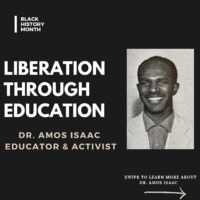 Dr. Amos Isaac lived a life dedicated to empowering the Black community in Redlands, CA through education, activism, and service. Born on April 28, 1934, Amos Isaac moved to San Bernardino, CA from Briley, TX, and grew up in the Valley Truck farm community. He was so passionate about education that he walked from San Bernardino to the University of Redlands to attain his master’s degree. He later attended Claremont graduate school, earning a doctorate in education. Dr. Isaac was the second Black person to teach in the Redlands Unified School District (RUSD). Outside the classroom, Dr. Isaac was active in the local community as he served in the Concerned Citizens organization, dedicated to improving the quality of education for all students in Redlands schools. Dr. Isaac also was a longtime advocate for fair housing and a leader in the NAACP and Westside Action Group in the Inland Empire.
Dr. Amos Isaac lived a life dedicated to empowering the Black community in Redlands, CA through education, activism, and service. Born on April 28, 1934, Amos Isaac moved to San Bernardino, CA from Briley, TX, and grew up in the Valley Truck farm community. He was so passionate about education that he walked from San Bernardino to the University of Redlands to attain his master’s degree. He later attended Claremont graduate school, earning a doctorate in education. Dr. Isaac was the second Black person to teach in the Redlands Unified School District (RUSD). Outside the classroom, Dr. Isaac was active in the local community as he served in the Concerned Citizens organization, dedicated to improving the quality of education for all students in Redlands schools. Dr. Isaac also was a longtime advocate for fair housing and a leader in the NAACP and Westside Action Group in the Inland Empire. -
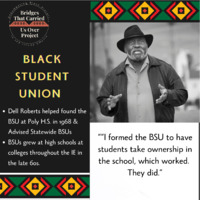 Student activists demanded the creation of Black Student Unions (BSU) at high schools and colleges throughout the Inland Empire in the late 1960s. Students successfully won BSU and MeCHa chapters in the schools after protests at Cajon High School in 1969 as school desegregation efforts escalated tensions among youth. With the help of Dell Roberts and Pete Anderson, Poly High School was able to establish a Black Student Union in 1968. Under these organizations, the students were able to bring forth a list of demands to the administration. One of which was a black history class taught by Woody-Rocker Hughes. Lorna Carry worked with the BSU at UCR, mostly writing letters and signing petitions to increase support for Black studies.
Student activists demanded the creation of Black Student Unions (BSU) at high schools and colleges throughout the Inland Empire in the late 1960s. Students successfully won BSU and MeCHa chapters in the schools after protests at Cajon High School in 1969 as school desegregation efforts escalated tensions among youth. With the help of Dell Roberts and Pete Anderson, Poly High School was able to establish a Black Student Union in 1968. Under these organizations, the students were able to bring forth a list of demands to the administration. One of which was a black history class taught by Woody-Rocker Hughes. Lorna Carry worked with the BSU at UCR, mostly writing letters and signing petitions to increase support for Black studies. -
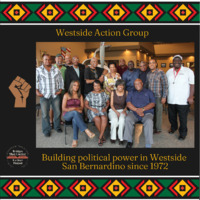 In 1972, Hardy Brown and Bob Parker founded the Westside Action Group (WAG) with the mission of becoming a political action organization to influence the political and economic agenda for the Black community in San Bernardino, CA. The organization began as a gathering of Black men at Checkers Cafe on Mount Vernon and Goodlett Street in San Bernardino. Bob Parker, WAG’s pioneering co-founder, and its first president, said in the first news article on June 8, 1972, “The group was formed out of necessity. The community has suffered because elected officials quickly forgotten campaign promises made to individuals.”
In 1972, Hardy Brown and Bob Parker founded the Westside Action Group (WAG) with the mission of becoming a political action organization to influence the political and economic agenda for the Black community in San Bernardino, CA. The organization began as a gathering of Black men at Checkers Cafe on Mount Vernon and Goodlett Street in San Bernardino. Bob Parker, WAG’s pioneering co-founder, and its first president, said in the first news article on June 8, 1972, “The group was formed out of necessity. The community has suffered because elected officials quickly forgotten campaign promises made to individuals.” -
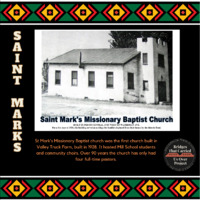 In 1928, St Mark’s Missionary Baptist church was the first church built in Valley Truck Farms on Central just west of Waterman Ave. In its early days it was a refuge for people displaced by a historic flood in the region and later became overflow space for the growing Mill School. The church served the community for over 90 years and only had four full-time pastors.
In 1928, St Mark’s Missionary Baptist church was the first church built in Valley Truck Farms on Central just west of Waterman Ave. In its early days it was a refuge for people displaced by a historic flood in the region and later became overflow space for the growing Mill School. The church served the community for over 90 years and only had four full-time pastors. -
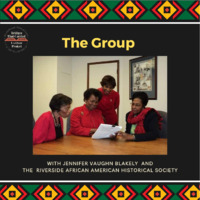 Jennifer Vaughn Blakely was a key leader of The Group, working alongside the Riverside African American Historical Society. Jennifer Vaughn Blakely also founded the Eleanor Jean Grier Leadership Academy that focused on leadership training for women, people of color, and underrepresented individuals.
Jennifer Vaughn Blakely was a key leader of The Group, working alongside the Riverside African American Historical Society. Jennifer Vaughn Blakely also founded the Eleanor Jean Grier Leadership Academy that focused on leadership training for women, people of color, and underrepresented individuals. -
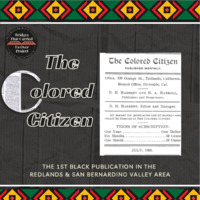 Managed by Robert H. Harbert, "The Colored Citizen" newspaper was the first Black publication in the Redlands and San Bernardino Valley area. It was printed monthly and featured news about the Black community in Redlands and the broader Inland Empire region. The first edition of "The Colored Citizen," published in July 1905, featured an article on the graduation of Charles Arthur Beal. Beal, the son of Israel Beal, was the first Black graduate and athlete (football) at Redlands Union High School.
Managed by Robert H. Harbert, "The Colored Citizen" newspaper was the first Black publication in the Redlands and San Bernardino Valley area. It was printed monthly and featured news about the Black community in Redlands and the broader Inland Empire region. The first edition of "The Colored Citizen," published in July 1905, featured an article on the graduation of Charles Arthur Beal. Beal, the son of Israel Beal, was the first Black graduate and athlete (football) at Redlands Union High School. -
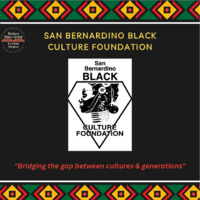 The Black Culture Foundation has its roots in the Black History Parade committee, which sponsored Black History parades in San Bernardino starting in the late 1960s. Key early leaders included Jim King, Juanita Scott, Alonzo Thompson, and Margaret Hill who helped coordinate the Black History parade and celebrations for decades. By the late 1980s, the group changed its focus to supporting students with scholarships, instead of just hosting the Black history day parade. They changed their name to the Black Culture Foundation and have given more than 125 scholarships to local students. The Black Culture Foundation also played a leading role in organizing the construction of the Rosa Parks statue that was unveiled in 2018 in front of the Rosa Parks Memorial Building in San Bernardino. The Black Culture Foundation has been hosting the Black Rose Awards for 20 years, honoring trailblazers and community members making a difference. Launched by Jim King, the Black Rose Award aims to change the narrative for Black communities by highlighting Black excellence and reclaiming the message that Black, like a rose, is beautiful.
The Black Culture Foundation has its roots in the Black History Parade committee, which sponsored Black History parades in San Bernardino starting in the late 1960s. Key early leaders included Jim King, Juanita Scott, Alonzo Thompson, and Margaret Hill who helped coordinate the Black History parade and celebrations for decades. By the late 1980s, the group changed its focus to supporting students with scholarships, instead of just hosting the Black history day parade. They changed their name to the Black Culture Foundation and have given more than 125 scholarships to local students. The Black Culture Foundation also played a leading role in organizing the construction of the Rosa Parks statue that was unveiled in 2018 in front of the Rosa Parks Memorial Building in San Bernardino. The Black Culture Foundation has been hosting the Black Rose Awards for 20 years, honoring trailblazers and community members making a difference. Launched by Jim King, the Black Rose Award aims to change the narrative for Black communities by highlighting Black excellence and reclaiming the message that Black, like a rose, is beautiful. -
 The Prince Hall Masonic Lodge #17 was first founded in Redlands but moved to San Bernardino in the 1920s. Early members helped build the social, economic, and political foundation of San Bernardino’s Black community, including founding the San Bernardino NAACP. Under the leadership of W.S. Johnson and John Lee, they formed the Westside Masonic Building Association in the 1920s to construct a large two-story brick building at the corner of 8th and Perris, which became a social, economic and political center of the community. W.S. Johnson described the building as “a dream of ours for years” and explained that the building was needed “for social affairs for our young people, for entertainments and meetings which are not religious and therefore hardly proper in our churches.” The Masons and later American Legion Post 710 met in the Masonic building, as did the Negro Welfare League which hosted Mary Bethune McCleod, founder of NCNW, in 1938. Early businesses in the complex included the Harlem Café, a pool hall, a real estate agent, and Golden State Mutual Insurance. Prince Hall Masonic Lodge has remained active in San Bernardino, raising money for scholarships, supporting civil rights, hosting Black history celebrations, and building community.
The Prince Hall Masonic Lodge #17 was first founded in Redlands but moved to San Bernardino in the 1920s. Early members helped build the social, economic, and political foundation of San Bernardino’s Black community, including founding the San Bernardino NAACP. Under the leadership of W.S. Johnson and John Lee, they formed the Westside Masonic Building Association in the 1920s to construct a large two-story brick building at the corner of 8th and Perris, which became a social, economic and political center of the community. W.S. Johnson described the building as “a dream of ours for years” and explained that the building was needed “for social affairs for our young people, for entertainments and meetings which are not religious and therefore hardly proper in our churches.” The Masons and later American Legion Post 710 met in the Masonic building, as did the Negro Welfare League which hosted Mary Bethune McCleod, founder of NCNW, in 1938. Early businesses in the complex included the Harlem Café, a pool hall, a real estate agent, and Golden State Mutual Insurance. Prince Hall Masonic Lodge has remained active in San Bernardino, raising money for scholarships, supporting civil rights, hosting Black history celebrations, and building community. -
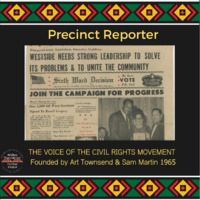 The "Precinct Reporter" was founded by Art Townsend and Sam Martin in July 1965. Townsend and Martin understood the necessity for Black residents of the Inland Empire to have a newspaper that represented their voice and their local community. They carefully crafted a newspaper to help people of the region understand the events occurring near their homes. The "Precinct Reporter" was a key voice for civil rights in the city reporting weekly on the activities of the Community League of Mothers as they fought to end school desegregation in San Bernardino, CA. During this time, Frances Grice remembers how, “ We were front page in the Precinct Reporter so all the white people start to [run] to get the Precinct Reporter before it got off the press!”
The "Precinct Reporter" was founded by Art Townsend and Sam Martin in July 1965. Townsend and Martin understood the necessity for Black residents of the Inland Empire to have a newspaper that represented their voice and their local community. They carefully crafted a newspaper to help people of the region understand the events occurring near their homes. The "Precinct Reporter" was a key voice for civil rights in the city reporting weekly on the activities of the Community League of Mothers as they fought to end school desegregation in San Bernardino, CA. During this time, Frances Grice remembers how, “ We were front page in the Precinct Reporter so all the white people start to [run] to get the Precinct Reporter before it got off the press!” -
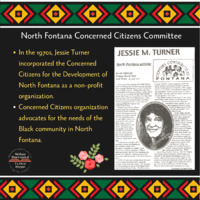 Established by the late Jessie Turner and her daughter Ellen Turner, The Concerned Citizens for the Development of North Fontana was incorporated as a non-profit organization in the 1970s. The Concerned Citizens organization advocates for the needs of the Black community in North Fontana and established the North Fontana Culinary Training Program along with the "Fontana Messenger", a local newspaper highlighting news in North Fontana’s Black community. Additionally, the Black Awareness Parade began more than 50 years ago to unify Black families in North Fontana.
Established by the late Jessie Turner and her daughter Ellen Turner, The Concerned Citizens for the Development of North Fontana was incorporated as a non-profit organization in the 1970s. The Concerned Citizens organization advocates for the needs of the Black community in North Fontana and established the North Fontana Culinary Training Program along with the "Fontana Messenger", a local newspaper highlighting news in North Fontana’s Black community. Additionally, the Black Awareness Parade began more than 50 years ago to unify Black families in North Fontana. -
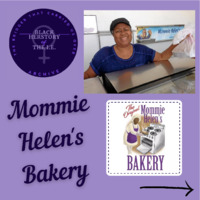 The Original Mommie Helen’s Bakery first opened in 2000 in Colton, CA by founder Dorothy Pryor Rose. Rose’s creations, like her famous sweet potato pie, delighted patrons all over the Inland Empire and received national notoriety by being featured in the Wall Street Journal and "O," the Oprah Winfrey magazine. Years later the bakery moved to San Bernardino and expanded both their square-footage and their menu. Rose gave over ownership of the bakery to her daughter Tedra Rose and stayed involved as a consultant until her passing in 2016. Tedra continues her mother’s legacy of serving the community mouthwatering desserts. The bakery also served as a location for community service when Tedra partnered with a community organization and invited children at a local school to take a tour of the bakery and learn about its operations.
The Original Mommie Helen’s Bakery first opened in 2000 in Colton, CA by founder Dorothy Pryor Rose. Rose’s creations, like her famous sweet potato pie, delighted patrons all over the Inland Empire and received national notoriety by being featured in the Wall Street Journal and "O," the Oprah Winfrey magazine. Years later the bakery moved to San Bernardino and expanded both their square-footage and their menu. Rose gave over ownership of the bakery to her daughter Tedra Rose and stayed involved as a consultant until her passing in 2016. Tedra continues her mother’s legacy of serving the community mouthwatering desserts. The bakery also served as a location for community service when Tedra partnered with a community organization and invited children at a local school to take a tour of the bakery and learn about its operations. -
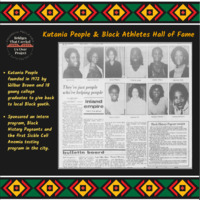 The Kutania People was a group founded in 1972 by President Wilbur Brown and a core group of 18 young college graduates who wanted to give back to local Black youth. These volunteers launched an intern program, sponsored Black history pageants, and created the first Sickle Cell Anemia testing program in the city. They also collaborated with the Sportsmen Athletic Club to host the Black Athlete Hall of Fame, an event founded by Loonie Taylor and Leonard Jacks. These lavish celebrations brought Black sports icons, celebrities, and business leaders together to celebrate the accomplishments of former local high school athletes with the goal of inspiring and supporting Black youth.
The Kutania People was a group founded in 1972 by President Wilbur Brown and a core group of 18 young college graduates who wanted to give back to local Black youth. These volunteers launched an intern program, sponsored Black history pageants, and created the first Sickle Cell Anemia testing program in the city. They also collaborated with the Sportsmen Athletic Club to host the Black Athlete Hall of Fame, an event founded by Loonie Taylor and Leonard Jacks. These lavish celebrations brought Black sports icons, celebrities, and business leaders together to celebrate the accomplishments of former local high school athletes with the goal of inspiring and supporting Black youth. -
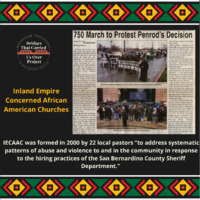 On February 21, 2000 the Inland Empire Concerned African American Churches (IECAAC) marched in the rain with the NAACP and over 750 protestors to protest San Bernardino Sheriff Department’s decision to hire one of the officers involved in the shooting death of teenager Tyisha Miller in Riverside, CA. The faith community was galvanized by the Sheriff’s department decision to hire Paul Bugar despite the fact that he had been fired from the Riverside Department and was under investigation by the US Justice Department for civil rights violations.
On February 21, 2000 the Inland Empire Concerned African American Churches (IECAAC) marched in the rain with the NAACP and over 750 protestors to protest San Bernardino Sheriff Department’s decision to hire one of the officers involved in the shooting death of teenager Tyisha Miller in Riverside, CA. The faith community was galvanized by the Sheriff’s department decision to hire Paul Bugar despite the fact that he had been fired from the Riverside Department and was under investigation by the US Justice Department for civil rights violations. -
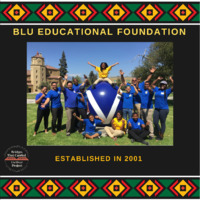 Blu Educational Foundation was established in 2001 “as a response to the higher education challenges faced by families with limited income and opportunities in the California’s Inland Empire.” Led by President and CEO Dina Walker, the BLU Educational Foundation develops mentoring, academic advising, college tours, parent involvement, internships, and financial aid that create pathways to college for youth in the region.
Blu Educational Foundation was established in 2001 “as a response to the higher education challenges faced by families with limited income and opportunities in the California’s Inland Empire.” Led by President and CEO Dina Walker, the BLU Educational Foundation develops mentoring, academic advising, college tours, parent involvement, internships, and financial aid that create pathways to college for youth in the region. -
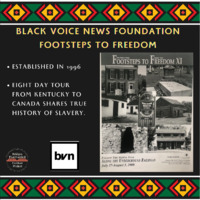 The Black Voice News Foundation’s "Footsteps to Freedom" program “teaches empathy through history” according to Hardy Brown Jr. Since 1996, the Black Voice News Foundation has been leading teachers and school administrators on an 8 day tour to immerse them in the true history of slavery and the long quest for Black freedom. The tour follows a path from Kentucky to Canada, visiting important sites on the Underground Railroad and exploring the impact of slavery on our nation.
The Black Voice News Foundation’s "Footsteps to Freedom" program “teaches empathy through history” according to Hardy Brown Jr. Since 1996, the Black Voice News Foundation has been leading teachers and school administrators on an 8 day tour to immerse them in the true history of slavery and the long quest for Black freedom. The tour follows a path from Kentucky to Canada, visiting important sites on the Underground Railroad and exploring the impact of slavery on our nation. -
 Black students initially founded the "Black Voice News" at UC Riverside (UCR) in 1972, when frustrated by local newspapers that refused to publish issues of concern to student activists. Led by Artis Lily, the students wanted to "plead their own cause" at UCR. Upon graduation, the newspaper transitioned to community ownership, and Sam Martin served as publisher. Cheryl Brown and Hardy Brown had worked alongside Mr. Martin at the "Precinct Reporter" and then later at Black Voice News. Cheryl Brown remembers, "Hardy would tell me… you know, you need to go and help Mr. Martin. And I said, Okay, so [I] bundled up the baby, my grandmother, and we would go to his house... And we would go and help him with the newspaper."
Black students initially founded the "Black Voice News" at UC Riverside (UCR) in 1972, when frustrated by local newspapers that refused to publish issues of concern to student activists. Led by Artis Lily, the students wanted to "plead their own cause" at UCR. Upon graduation, the newspaper transitioned to community ownership, and Sam Martin served as publisher. Cheryl Brown and Hardy Brown had worked alongside Mr. Martin at the "Precinct Reporter" and then later at Black Voice News. Cheryl Brown remembers, "Hardy would tell me… you know, you need to go and help Mr. Martin. And I said, Okay, so [I] bundled up the baby, my grandmother, and we would go to his house... And we would go and help him with the newspaper." -
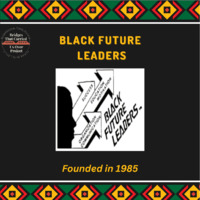 Black Future Leaders was founded in 1985 with the purpose of ensuring high-achieving Black students attended college. Jean Peacock modeled the program after Latino Future Leaders and recruited prominent members such as Lois Carson and Marion Black to create the project. Carson directed the project Upward Bound at UC Riverside before she established Black Future Leaders. California State University, San Bernardino served as the program’s home for several years and took in students from San Bernardino, Eisenhower, and Cajon high schools.
Black Future Leaders was founded in 1985 with the purpose of ensuring high-achieving Black students attended college. Jean Peacock modeled the program after Latino Future Leaders and recruited prominent members such as Lois Carson and Marion Black to create the project. Carson directed the project Upward Bound at UC Riverside before she established Black Future Leaders. California State University, San Bernardino served as the program’s home for several years and took in students from San Bernardino, Eisenhower, and Cajon high schools. -
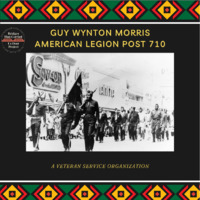 American Legion Post 710 was founded and led early on by returning veterans James Guy, Edward Greer, Jack Hill, Talmadge Hughes, Henry Hooks, Willie Roberts, Ed Hooks, P.K. Blakely, Art Townsend, Edgar Slaughter, Jesse Smith, Curtis Boat, Oscar Hemington, Thomas Bonderant, Jerome Sneed, and Milton Johnson. It was located in the Black-owned business center at 8th and Perris, meeting in what was sometimes called “Harlem Hall” alongside the first Golden State Mutual and Prince Hall Lodge. In 1953, it moved to a new facility opened at 2181 West Highland. Many early members became longtime community leaders, and some like Art Townsend became key leaders of the NAACP and longtime advocates for civil rights.
American Legion Post 710 was founded and led early on by returning veterans James Guy, Edward Greer, Jack Hill, Talmadge Hughes, Henry Hooks, Willie Roberts, Ed Hooks, P.K. Blakely, Art Townsend, Edgar Slaughter, Jesse Smith, Curtis Boat, Oscar Hemington, Thomas Bonderant, Jerome Sneed, and Milton Johnson. It was located in the Black-owned business center at 8th and Perris, meeting in what was sometimes called “Harlem Hall” alongside the first Golden State Mutual and Prince Hall Lodge. In 1953, it moved to a new facility opened at 2181 West Highland. Many early members became longtime community leaders, and some like Art Townsend became key leaders of the NAACP and longtime advocates for civil rights. -
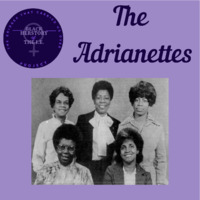 The Adrianettes was a civic and social group of ten Black women in Redlands, CA which formed in 1968. Together these women made significant strides for the Black community in Redlands. Most notably, they sponsored the Caesar Hangan Memorial Scholarship. Caesar Hangan was a phenomenal football player at Redlands High School and received a scholarship to play football at Whitworth College.
The Adrianettes was a civic and social group of ten Black women in Redlands, CA which formed in 1968. Together these women made significant strides for the Black community in Redlands. Most notably, they sponsored the Caesar Hangan Memorial Scholarship. Caesar Hangan was a phenomenal football player at Redlands High School and received a scholarship to play football at Whitworth College. -
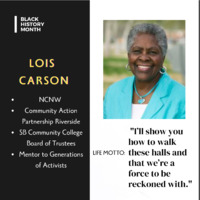 Lois Carson’s legacy looms large over the Inland Empire. Black Future Leaders is one of the many organizations she helped found. While directing Upward Bound at UC Riverside (UCR), Carson recognized that few programs focused solely on high-achieving Black youth. Jean Peacock reached out to Lois Carson in 1985 to help establish Black Future Leaders, with the goal to expose high-achieving African American students to university campuses throughout the region via field trips and summer residences to UCR, California State University, San Bernardino, and the University of Redlands. In 2016, Carson remarked that Black Future Leaders had a 95-99 percent college-going rate with numerous successful alumni in fields ranging from medicine and architecture to poetry.
Lois Carson’s legacy looms large over the Inland Empire. Black Future Leaders is one of the many organizations she helped found. While directing Upward Bound at UC Riverside (UCR), Carson recognized that few programs focused solely on high-achieving Black youth. Jean Peacock reached out to Lois Carson in 1985 to help establish Black Future Leaders, with the goal to expose high-achieving African American students to university campuses throughout the region via field trips and summer residences to UCR, California State University, San Bernardino, and the University of Redlands. In 2016, Carson remarked that Black Future Leaders had a 95-99 percent college-going rate with numerous successful alumni in fields ranging from medicine and architecture to poetry. -
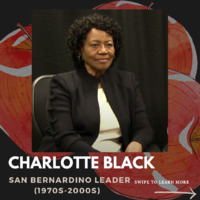 Charlotte Black demonstrated leadership as a teacher and community leader for many years in San Bernardino, CA.
Charlotte Black demonstrated leadership as a teacher and community leader for many years in San Bernardino, CA. -
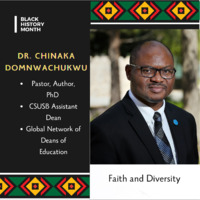 Pastor, Scholar, and Educator, Dr. Chinaka DomNwachukwu has made strides in the fields of diversity and intercultural studies blending faith and diversity in his teachings. DomNwachukwu has served as a prominent figure in various community sectors from religion, K-12 education, and now as Dean of Education at California State University, San Bernardino. Dr. Domnwachukwu holds a Ph.D. in Intercultural Studies, with an emphasis in Cultural Anthropology and Leadership Development from Fuller Theological Seminary in Pasadena California. He has spent his educational career tirelessly working with faculty on their own professional development and curricular formation, lending his passion and expertise in the two pillars of faith and diversity. With 20 years of experience in higher education, Dr. DomNwachukwu has lent his research to numerous textbooks, including two published chapters in a McGraw-Hill book titled, "Connecting English Language Learners to the Cross-Cultural Methodology" which is today part of the curriculum at several California universities.
Pastor, Scholar, and Educator, Dr. Chinaka DomNwachukwu has made strides in the fields of diversity and intercultural studies blending faith and diversity in his teachings. DomNwachukwu has served as a prominent figure in various community sectors from religion, K-12 education, and now as Dean of Education at California State University, San Bernardino. Dr. Domnwachukwu holds a Ph.D. in Intercultural Studies, with an emphasis in Cultural Anthropology and Leadership Development from Fuller Theological Seminary in Pasadena California. He has spent his educational career tirelessly working with faculty on their own professional development and curricular formation, lending his passion and expertise in the two pillars of faith and diversity. With 20 years of experience in higher education, Dr. DomNwachukwu has lent his research to numerous textbooks, including two published chapters in a McGraw-Hill book titled, "Connecting English Language Learners to the Cross-Cultural Methodology" which is today part of the curriculum at several California universities. -
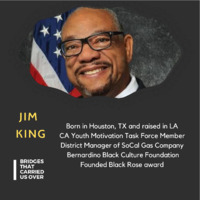 Jim King was a long time leader in the Black Culture Foundation and Black Future Leaders organizations.
Jim King was a long time leader in the Black Culture Foundation and Black Future Leaders organizations. -
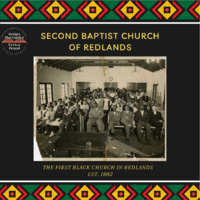 The Second Baptist Church of Redlands is the first Black church in the city. Established in 1892, Second Baptist Church was the first church for Black people to attend. Israel Beal, the first Black person to settle in Redlands was one of the founding members and served as an elder. Second Baptist was known early on for their quartet singers and for establishing the Citrus Valley District Usher Board, one of eight districts representing the Union Usher Board State of California, Inc.
The Second Baptist Church of Redlands is the first Black church in the city. Established in 1892, Second Baptist Church was the first church for Black people to attend. Israel Beal, the first Black person to settle in Redlands was one of the founding members and served as an elder. Second Baptist was known early on for their quartet singers and for establishing the Citrus Valley District Usher Board, one of eight districts representing the Union Usher Board State of California, Inc. -
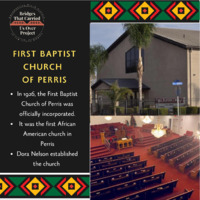 Dora Nelson established the First Baptist Church of Perris, CA. Born in slavery in 1852, Dora Nelson moved to Perris, CA with her granddaughters in the early 1920’s. As her brother-in-law moved to Perris in 1905, it is assumed that Nelson’s family was one of the first Black families to settle in the area. As there was no Black church for the local community, Dora began hosting prayer meetings in her home, located on F and Sixth Streets. As the meetings began outgrowing her home, people gathered in her yard under her ChinaBerry tree. From this location, the First Baptist Church of Perris was established. As local ministers assisted with ministerial duties, credit wasn’t given to Dora for establishing the church. On November 26, 1926, First Baptist Church of Perris was officially incorporated.
Dora Nelson established the First Baptist Church of Perris, CA. Born in slavery in 1852, Dora Nelson moved to Perris, CA with her granddaughters in the early 1920’s. As her brother-in-law moved to Perris in 1905, it is assumed that Nelson’s family was one of the first Black families to settle in the area. As there was no Black church for the local community, Dora began hosting prayer meetings in her home, located on F and Sixth Streets. As the meetings began outgrowing her home, people gathered in her yard under her ChinaBerry tree. From this location, the First Baptist Church of Perris was established. As local ministers assisted with ministerial duties, credit wasn’t given to Dora for establishing the church. On November 26, 1926, First Baptist Church of Perris was officially incorporated.